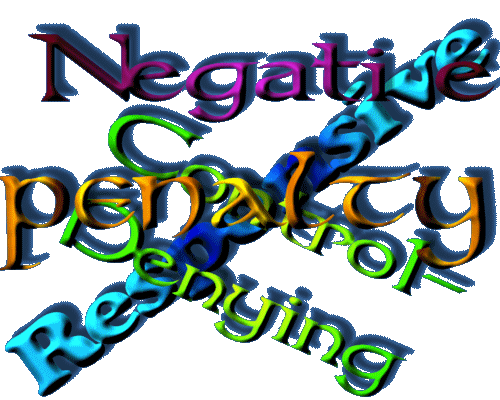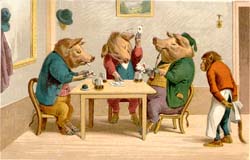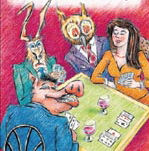 Doubles
Doubles
Penalty Doubles have their place at the Bridge table, no question. There are few things more satisfying than writing down "+1100" when you only had a part-score on your way. Obtaining a big penalty at relatively low levels, however, is a fairly rare event, which is why so many non-penalty doubles have appeared on the scene over the years. These include Negative, Responsive, Competitive, Support, Snapdragon and a plethora of other doubles used where conveying additional information to Partner is a more constructive use of Double than applying the big axe.There are numerous special doubles in specific situations detailed elsewhere on this site. This page deals with the more general doubles available, mostly in natural sequences. None of these are purely for penalties, though they can be passed for penalties on many occasions. Similarly, they are not all for takeout. Mostly, they convey specific information or ask specific questions.
Where special doubles in specific sequences have been covered elsewhere they are not repeated here. These are more general uses for doubles in natural sequences.
Takeout Doubles
The only thing to say about Takeout Doubles, in my view, is to be consistent in your approach and not to overuse them. Many people seem to feel it's required that they make a takeout double any time they have an Opening hand but no 5+-card suit to overcall. Just "making a noise" to remind everyone else at the table that you're still there is rarely worthwhile, in my experience. Takeout doubles are asking partner to bid something, but they may have no points and no fit with any of the unbid suits. Okay, you will sometimes come up against that situation even when you have a worthwhile takeout double, but the more suitable your hand is, the easier it will be for you and partner to find a safe resting spot.Another thing to remember is that if you have a 4-card holding in Opps' suit and a shortage elsewhere, this is almost certainly not a time to make a takeout double because, if your luck is anything like mine, it's a racing certainty that Partner will bid your short suit and now, if you have a bare 12-count, you are poorly placed to cope with subsequent developments. Takeout doubles promise at least 3-card support for any unbid suits. Off-centre takeout doubles are okay only if you have considerably more than basic opening strength, enough strength to cope with developments when you don't find an immediate fit with partner.
Negative Doubles
 In principle, OCP advocates the use of Negative Doubles up to the level of 4♦ over Intermediate Suit Openings. A Negative Double can be made when Partner opens and our RHO overcalls. It is essentially a takeout double, generally shows no good support for Opener's suit and tends to show length for the two unbid suits. It usually promises at least 4-card length in any unbid Major but sometimes is simply used to create a forcing rather than a non-forcing sequence. Bear in mind, though, that at the 2-level the availability of 2NT Lebensohl in competitive sequences is a more precise weapon than a negative double.
In principle, OCP advocates the use of Negative Doubles up to the level of 4♦ over Intermediate Suit Openings. A Negative Double can be made when Partner opens and our RHO overcalls. It is essentially a takeout double, generally shows no good support for Opener's suit and tends to show length for the two unbid suits. It usually promises at least 4-card length in any unbid Major but sometimes is simply used to create a forcing rather than a non-forcing sequence. Bear in mind, though, that at the 2-level the availability of 2NT Lebensohl in competitive sequences is a more precise weapon than a negative double.Negative doubles in this system show 8+ points in principle, although over a sequence such as 1♦-(1♠)-X it might be slightly weaker. Similarly once we get to the 3-level, negative doubles become correspondingly stronger, but still essentially for takeout, denying good support for Opener's suit and suggesting 4-card support for any unbid Majors.
Please note that over the sequence 1♥-(1♠)-?? a Double by Responder is not Negative but the "Forcing No Trump" bid (See System change dated 12th July 2019).
Competitive Doubles
 OCP uses these up to the level of 3♥ in the situation where opponents have agreed a suit at the 3-level. here a double shows an invitational raise in Partner's suit rather than a competitive one. Thus (1♣)-1♠-(3♣)-???. Here a bid of 3♠ from you is merely competing, but a Double is "Competitive", showing a genuinely invitational 3-level raise. The downside of this is that you cannot double 3♣ for penalties, but you get better value for money from the Competitive Double.
OCP uses these up to the level of 3♥ in the situation where opponents have agreed a suit at the 3-level. here a double shows an invitational raise in Partner's suit rather than a competitive one. Thus (1♣)-1♠-(3♣)-???. Here a bid of 3♠ from you is merely competing, but a Double is "Competitive", showing a genuinely invitational 3-level raise. The downside of this is that you cannot double 3♣ for penalties, but you get better value for money from the Competitive Double.In practice, you can also use Competitive Doubles at the 2-level when their suit is higher-ranking than ours. So (1♠) - 2♣ - (2♠) - ??? is a place where a Competitive Double can potentially be used to differentiate between a competitive 3♣ and an invitational 3♣. This is particularly useful when our suit is Clubs, because Competitive Lebensohl is of less benefit to us (...2NT-3♣-Pass doesn't give the 2♣ bidding the option of bidding on). Here a "fast" 3♣ is still encouraging, and a Competitive Double is a full-blown invitation. When our suit is not Clubs but their suit is still higher-ranking, Competitive Lebensohl is sufficient to our needs, so the Double can revert to the big axe.
Responsive Doubles
OCP uses these up to the level of 3♠. In practice because we have Lebensohl available in competitive sequences at the 2-level we tend to use Responsive Doubles mainly at the 1 or the 3-level. Responsive Doubles are used when Opps open the bidding, Partner makes a takeout double and our RHO bids. Now a double from us is "responsive" and also a takeout double. Thus in the sequence (1♣)-X-(1♥)-X the second Double is responsive, promising good support for Spades and Diamonds. At the 1-level a responsive double is not guaranteeing a lot of strength (but might be quite strong), whereas at the 3-level you are showing a fairly reasonable hand, prepared to compete further. So generally Responsive Doubles don't show any more strength than a "free" simple suit bid would but they do show good support for any unbid suits and invite Partner to take their pick.You can use responsive doubles at the 2-level, but the range of different bids available via Lebensohl will often enable you to show more precisely your range and shape. Responsive Doubles at the 2-level will almost always show hands of less than game-going strength, therefore, and are mainly aimed at competing effectively at the 2 or 3-level.
The use of Responsive Doubles can be particularly informative when you elect not to use them. Thus in the sequence (1♣)-X-(1♥)-2♦, there is a definite inference that you do not have 4-card Spades as well, or you might have made a Responsive Double. Both Responsive Double and 2♦ bid show values, since they are "free" bids, but it is your support for Spades and Diamonds that the Responsive Double is showing.
Support Doubles
Support Doubles occur when we have opened the bidding with a natural suit bid, Partner has made a change-of-suit response, and our RHO has overcalled something else. Now a raise of Partner's suit shows 4-card support, but a Double from us shows exactly 3-card support. For OCP users, this is particularly useful when Partner has bid a Major at the 1-level over our opening, and Opps then overcall, since Partner may only have a 4-card Major, but might be 5+-card.If Opps double rather than overcalling a suit in this situation, then a Support Redouble carries the same implication. Thus 1♦ - 1♠ - (X) - XX shows 3-card Spades whereas a raise to 2♠ promises 4-card support.
Support Doubles generally occur only at the 1 or 2-level, never at the 3-level.
3rd Suit Doubles
This name is somewhat confusing, I always feel. 3rd suit Doubles (also known as Snapdragon Doubles) are doubles of the 3rd suit, but relate to the 4th, unbid, suit: Where 3 suits have been bid naturally a double of the 3rd Suit shows the unbid suit unless this would clash with specific arrangements detailed elsewhere. For example (1♠)-2♦-(3♣)-X shows Hearts but will also imply a tolerance for Diamonds. These sequences do not occur frequently and if ending at the 2-level, Lebensohl will often provide a better solution to show strength and distribution.Non-Penalty Slam Doubles
These are used when it is clearly the Opponents' hand and we are considering whether or not to sacrifice over a high-level contract they have bid (ie: at the 6-level) or to double them. The method involved is as follows:2nd-in-Hand:
- Passes with 1 or more defensive tricks
- Doubles with no defensive tricks
4th-in-Hand:
- If 2nd-in-Hand passes
- Passes with 1 or more defensive tricks
- Doubles with no defensive tricks
(2nd-in-Hand now sacrifices with only 1 defensive trick)
- If 2nd-in-Hand doubles
- Passes with 2 or more defensive tricks
- Sacrifices with no or only 1 defensive trick
This will eliminate a lot of costly phantom sacrifices over contracts that aren't making. Nothing is certain, of course, and a lot will be down to the accuracy of your joint estimates of your defensive tricks (some of which might not materialise, but it does take out a lot of the guesswork involved and gives you a framework around which to work.
Control-Denying Doubles
These are also (confusingly) known as Control-Showing Doubles, which they absolutely are not! These are the opposite side of the coin to Non-Penalty Slam Doubles. These are used when it is our hand and opponents have sacrificed over a high-level contract that we have bid, in a sequence where 2nd-in-Hand over their sacrifice is not the Captain of the Hand (or where there is no firm Captain). The question at hand is whether we double their sacrifice or bid one more and Control of their suit has not yet been specifically been shown by cue-bids or an Asking Bid response. Now:2nd-in-Hand
- Passes with 1st Round Control of their suit (at the 6-level) or with 1st or 2nd Round Control (at the 5-level)
- Doubles with no such holding.
4th-in-Hand
...passes, doubles, or bids depending on their own holding.Important Note:
Bear in mind that the above does not apply when the Captain of the hand is sitting immediately over the opponent making the sacrifice bid, and does not apply if the question of control of their suit has already been settled. Most importantly, these do not apply when we are in the middle of an Asking Bid sequence: If the sacrifice is of a pre-emptive nature, then Pass by the Captain of the Hand is Lebensohl, demanding a Double from Partner, and therefore cannot be a Control-Denying Double. Similarly, if the sacrifice is not pre-emptive in nature (ie: not jumping at least one round of bidding) then Double and Pass are "asking" backwards.
OCP System Change Log
1♥-(1♠)-FNT Change (12-Jul-2019)
This change affects only the exact sequence 1♥-(1♠)-??. Previously 1NT remained the Forcing No Trump, but the effect of this change is that now a Double by Responder is no longer "negative" but rather the Forcing NT bid, and 1NT by Responder is simply natural and non-forcing with a Spade stop.If Responder Doubles the 1♠ overcall, then now 1NT by Opener is natural with a Spade stop. Essentially no other continuations are affected except that over 1♥-(1♠)-X-(no)-1NT-(No)-2♣/2♦ are now both natural and non-forcing (because we lost the negative double) and 2♠ is Gamma in Hearts. If Opener themselves rebids 2♣/2♦, then current arrangements apply (ie: cheapest new suit relay is Gamma in Spades, etc etc).

